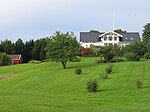Bærum Waldorf School
The Bærum Waldorf School (Norwegian: Steinerskolen i Bærum, lit. "The Steiner School in Bærum") is a private school in the Norwegian municipality of Bærum, a suburb west of Oslo. It is located in the borough of Jar, occupying the former agricultural property Grav. Hence, it is unofficially also referred to as Grav or the Grav Waldorf School (Steinerskolen på Grav). The school was established in August 1971, and is both an elementary and a secondary school, leading to the student exam. It was the second waldorf school to be established in the Oslo area (there are also three waldorf schools in Oslo and four other waldorf schools in Akershus.) The school has been attended by, among others, Maud Angelica Behn.
Excerpt from the Wikipedia article Bærum Waldorf School (License: CC BY-SA 3.0, Authors).Bærum Waldorf School
Grav gårdsvei, Bærum
Geographical coordinates (GPS) Address Nearby Places Show on map
Geographical coordinates (GPS)
| Latitude | Longitude |
|---|---|
| N 59.9303 ° | E 10.6059 ° |
Address
Grav gårdsvei 5
1358 Bærum, Jar
Norway
Open on Google Maps







